#High-Speed CAN Transceiver
Explore tagged Tumblr posts
Text
https://www.futureelectronics.com/p/semiconductors--comm-products--phy/ksz8721bli-microchip-6275010
High-Speed CAN Transceiver, ethernet PHY chip, Ethernet controller
KSZ8721B Series 2.5 V 10/100 Base TX/FX Physical Layer Transceiver - LQFP-48
#Comm Products#PHY#KSZ8721BL#Microchip#High-Speed CAN Transceiver#ethernet PHY chip#Ethernet controller#Ethernet MAC controller#communications products#electronic circuit#Physical Layer Transceiver#physical layer
1 note
·
View note
Text
https://www.futureelectronics.com/p/semiconductors--comm-products--can/mcp2551-e-sn-microchip-8463747
High-Speed CAN Transceiver, CAN Transceiver, Ethernet controller
MCP2551 Series 5.5 V 1 Mb/s Surface Mount High-Speed CAN Transceiver - SOIC-8
#Comm Products#CAN#MCP2551E/SN#Microchip#High-Speed CAN Transceiver#CAN Transceiver#Ethernet controller#CAN bus transceivers#Ethernet MAC controller#Low Power CAN#industrial equipment#CAN protocol controller
1 note
·
View note
Text
https://www.futureelectronics.com/p/semiconductors--comm-products--can/mcp2551-i-sn-microchip-5584800
Can Power Systems, Ethernet controller, High-Speed CAN Transceiver
MCP2551 Series 5.5 V 1 Mb/s Surface Mount High-Speed CAN Transceiver - SOIC-8
#Microchip#MCP2551-I/SN#Comm Products#CAN#Power Systems#Ethernet controller#High-Speed CAN Transceiver#Ethernet MAC controller#CAN Controller Interface#Can bus communication#Controller Interface Module#Module Bus Drive
1 note
·
View note
Text
https://www.futureelectronics.com/p/semiconductors--comm-products--can/mcp2551t-i-sn-microchip-5971353
High-Speed CAN Transceiver, can transceiver circuit, Can Power Systems
MCP2551 Series 5.5 V 1 Mb/s Surface Mount High-Speed CAN Transceiver - SOIC-8
#Microchip#MCP2551T-I/SN#Comm Products#CAN#High-Speed CAN Transceiver#can transceiver circuit#Can Power Systems#Can controller#can bus#can bus voltage#Can bus voltage measurement#Embedded communication
1 note
·
View note
Text
https://www.futureelectronics.com/p/semiconductors--comm-products--i2c/pca9532pw-118-nxp-5033862
I2c bus, Embedded communication, Isolated CAN Transceiver ICs
PCA9532 Series 5.5 V 350 uA 400kHz SMT 16-bit I2C-bus LED Dimmer - TSSOP-24
#NXP#PCA9532PW#118#Comm Products#I2C#Ethernet MAC controller#communication protocol#i2c module#bus#Embedded communication#Isolated CAN Transceiver ICs#High-Speed CAN Transceiver#CAN transceiver#SPI bus#CAN bus lines
1 note
·
View note
Text
https://www.futureelectronics.com/p/semiconductors--comm-products--i2c/pca9532pw-118-nxp-5033862
16-bit I2C-bus LED Dimmer, Embedded communication, image processing,
PCA9532 Series 5.5 V 350 uA 400kHz SMT 16-bit I2C-bus LED Dimmer - TSSOP-24
#NXP#PCA9532PW#118#Comm Products#I2C#16-bit I2C-bus LED Dimmer#Embedded communication#image processing#High-Speed#Isolated CAN Transceiver ICs#CAN bus lines#i2c modules#Can Power Systems#CAN transceiver#Ethernet MAC controller
1 note
·
View note
Text
https://www.futureelectronics.com/p/semiconductors--comm-products--can/mcp2551-e-p-microchip-7464399
Communication eval, Development kit, Ethernet solutions, image processing
MCP2551 Series 5.5 V 1 Mb/s Surface Mount High-Speed CAN Transceiver - SOIC-8
#Microchip#MCP2551-E/SN#Comm Products#CAN#Communication eval#Development kit#Ethernet solutions#image processing#tools#development board#Embedded#Surface Mount High-Speed CAN Transceiver#power management ic
1 note
·
View note
Text
800G Interconnects: Decoding the Differences Between AOC cables and DAC cables

In the rapidly evolving landscape of data centers and high-performance computing, the demand for higher bandwidth and faster interconnects is relentless. As network speeds push towards 800 Gigabit Ethernet (800G), understanding the fundamental differences between cabling solutions becomes critical for optimizing performance, cost, and efficiency. Two prominent contenders in this arena are Direct Attach Cables (DACs) and Active Optical Cables (AOCs). While both offer high-speed, pre-terminated connectivity, their underlying technology, performance characteristics, and ideal use cases diverge significantly, especially at 800G.
The Core Distinction: Copper vs. Optics
The most fundamental difference between an 800G AOC and a traditional DAC lies in their transmission medium:
Direct Attach Cable (DAC): As the name suggests, DACs utilize copper twinaxial cables for signal transmission. The electrical signals from the networking equipment are sent directly over the copper wires, with the transceivers on each end simply acting as passive or active (with signal conditioning) conduits. At 800G, these are often "active DACs" which include integrated circuitry to boost and equalize the electrical signals, extending their reach beyond passive copper limitations.
Active Optical Cable (AOC): AOCs, on the other hand, employ fiber optic strands for data transmission. Within the connector at each end of an AOC, there are integrated optical transceivers. These transceivers convert the electrical signals from the networking equipment into optical signals (light) for transmission over the fiber, and then convert them back to electrical signals at the receiving end.
Key Differentiating Factors at 800G:
The choice between an 800G AOC and a DAC hinges on several critical factors:
1. Transmission Distance:
DAC: DACs are primarily designed for short-reach interconnects, typically within a single rack or adjacent racks. At 800G, the maximum practical transmission distance for DACs is quite limited, usually to a few meters (e.g., 2-3 meters, though some active DACs might push slightly further). Beyond this, signal degradation due to attenuation and crosstalk becomes prohibitive.
AOC: AOCs leverage the inherent advantages of fiber optics, enabling significantly longer transmission distances. 800G AOCs can typically extend up to 50-100 meters, making them ideal for inter-rack, intra-row, or even short inter-row connections within a data center.
2. Signal Integrity and Electromagnetic Interference (EMI):
DAC: Copper cables are susceptible to electromagnetic interference (EMI) and crosstalk, especially at higher data rates like 800G. This can lead to signal degradation, increased bit error rates, and reduced reliability, particularly in electrically noisy environments. The bulk of copper cables also increases with higher speeds due to the need for more shielding.
AOC: Since AOCs transmit data as light signals over fiber optic strands, they are immune to EMI. This inherent immunity ensures superior signal integrity and highly reliable data transmission, making them a robust solution for demanding data center environments.
3. Flexibility and Weight:
DAC: As data rates increase, DACs become thicker, heavier, and less flexible due to the increased copper content and shielding required. This can pose challenges for cable management, especially in densely packed racks.
AOC: Fiber optic cables are inherently much thinner and lighter than their copper counterparts. This makes 800G AOCs significantly more flexible and easier to route and manage within racks, contributing to better airflow and reduced physical strain on equipment ports.
4. Power Consumption:
DAC: Passive DACs consume virtually no power, as they are essentially just copper wires. Active DACs, however, do consume some power for their integrated signal conditioning circuitry, although typically less than AOCs over very short distances.
AOC: AOCs require power to operate their integrated optical transceivers, which perform electrical-to-optical and optical-to-electrical conversions. This means 800G AOCs generally have higher power consumption compared to passive DACs, though advancements are continually reducing this.
5. Cost:
DAC: For very short distances, DACs generally offer a lower upfront cost compared to AOCs. The simplicity of copper manufacturing contributes to this cost advantage.
AOC: While the cost of AOCs has decreased over time, they are still typically more expensive per unit than DACs, primarily due to the integrated optical components. However, for longer distances where DACs are not feasible, AOCs become the more cost-effective solution when considering the alternative of separate transceivers and fiber optic patch cables.
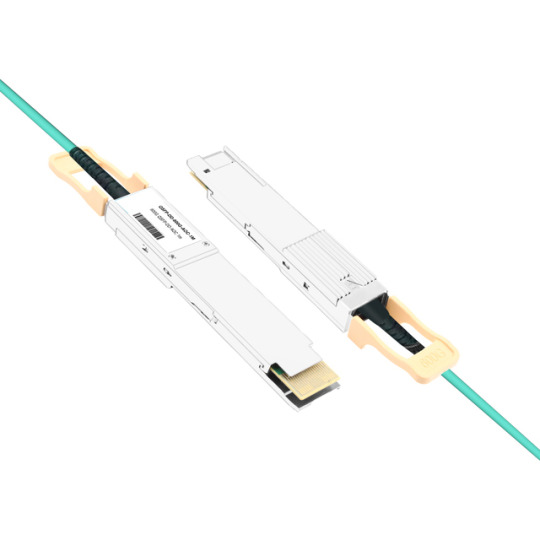
800G Use Cases and Considerations for SEO Inclusion:
When planning 800G deployments, the choice between AOCs and DACs directly impacts network architecture and operational efficiency.
800G DACs are the preferred choice for:
Intra-rack connectivity: Connecting servers to Top-of-Rack (ToR) switches within the same rack.
Cost-sensitive, very short-reach applications: Where budget is a primary concern and distances are minimal.
Low power consumption needs: For the shortest links where passive DACs can be utilized.
800G AOCs are essential for:
Inter-rack and intra-row connectivity: Linking switches and servers across different racks or within the same row.
High-density data centers: Where cable management and airflow are critical.
Environments with high EMI: Ensuring reliable data transmission in electrically noisy settings.
High-performance computing (HPC) clusters: Where low latency and robust signal integrity over moderate distances are paramount.
Cloud infrastructure: For efficient and scalable interconnects across distributed server environments.
In conclusion, while 800G DACs offer a cost-effective and power-efficient solution for ultra-short distances, 800G AOCs are indispensable for extending reach, enhancing signal integrity, and simplifying cable management in the demanding 800G landscape of modern data centers. The decision between them boils down to a careful evaluation of distance requirements, environmental factors, power budgets, and overall cost-effectiveness for each specific link.
2 notes
·
View notes
Text
Bosses
Occasionally, Sonic will come across abandoned Badniks that he must defeat in battle in order to progress. During this time, the in-game timer slows down to half-speed (except on hard difficulty, where the timer will continue at regular speed).
Interested in learning more about Sonic Icebound? Visit this document to read up!
Further information on Icebound's bosses below the cut:
E-109 Kappa

(Sketch and description courtesy of stellar.seeker on Discord)
The game’s first boss, encountered right before the player traverses the Transantarctic Mountains. Originally meant for deep-sea resource gathering expeditions in the Antarctic, Eggman's defeat and subsequent disappearance at the end of Forces cut it off from the network. Left to its own devices, the super-Badnik slowly developed sapience, and then went mad from its isolation.
Due to not being as long-abandoned as the others on the continent (known collectively as Scrapniks), it's still in decent shape, but has taken parts from other Badniks to make itself more dangerous. Among the various parts it has taken include a high-powered speaker that emits a high amount of infrasonic noise, which is known to trigger the brain’s fear response. In turn, this exacerbates Sonic's paranoia and weakens his attack strength and accuracy.
E-110 Lambda

(Sketch courtesy of TomtomtheMultitasker7238 on Discord)
The game’s second boss, encountered deep inside a glacier cave system. With a small and nimble build, Lambda relies on stealth and speed to win fights. Part of a group of other Badniks that conducted caving expeditions, Lambda became disoriented in the winding cave system and got lost, unable to find their way out and with no means of reaching Eggman.
It treats anything that moves as a threat but refuses to make the first move. Its elite agility enables it to dodge quick attacks, but Lambda also has little attack strength. Because of this, it prefers to whittle down enemies rather than try to deal large amounts of damage at once. Sonic’s saving grace is the fact the narrower passages of the caves make it more difficult for Lambda to dodge, but the robot will become extremely aggressive very quickly if it is cornered.
E-111 Iota
The game’s third boss, encountered near the summit of Mount Sidley. Iota got its start as a sentient sentry gun, originally meant to guard a prime Eggman base in the Weiss Amphitheater (a two-nautical mile wide caldera on Sidley’s south-central face) below. After the events of Adventure 2 and the resulting political fallout, Eggman left the Sidley-Weiss base to rot in favor of a new base closer to the Ross Ice Shelf. With Iota among those left behind, it refuses to abandon its post and still believes the base to be in active use.
It has a very high attack power and can make quick work of Sonic if the latter is not careful, and has near-perfect accuracy. However, its movement speed is slow and can also decrease its accuracy. Furthermore, it has weak spots in its armor that Sonic can take advantage of by using his speed for quick hits. Its arms wield rocket launchers that it only uses when in extreme peril. It does even more damage than the normal bullet-based weaponry it uses at the cost of a significant decrease in accuracy.
After the fight against E-111 Iota, Sonic’s radio transceiver dies and loses all communication with Tails. It becomes unusable until the game’s final boss; attempts to use it beforehand will return static noise to Sonic.
Simulacrum
The game’s final boss, encountered just before Sonic gets to the evacuation site. Simulacrum is not a truly physical being; rather, it is a manifestation of Sonic’s own paranoia and fears of isolation. This boss has two regular phases, taking on a different form in each: one as Tails, one as Knuckles. In these states, Simulacrum will occasionally go semi-visible if the player moves towards them, with their location only denoted by a bright, thin outline of them.
The first three phases consist of guiding Sonic through a vast icy labyrinth with multiple twists and turns. Simulacrum will attempt to misdirect the player by impersonating one of Sonic’s friends depending on which phase the boss is in. Meanwhile, Tails (and later, Knuckles) will attempt to guide the player along the correct path to get out of the labyrinth. Instructions from both Simulacrum and Sonic’s friends are similar but have subtle differences that Sonic will need to decipher in order to choose the correct path. Choosing the wrong path will ultimately steer the player into one of many snow-covered pitfalls.
After the first three phases, Simulacrum will enter a fourth and final phase where they take on the form of the aurora australis (also known as the Southern Lights). Sonic will be sent to the top of a large hill where he will have to outrun a fast-moving avalanche, dodging obstacles in the process. When Sonic emerges from the crevasse, the player will then complete a series of quick-time events to defeat Simulacrum and get to the evacuation site where Tails is waiting (unless the in-game timer runs out before Simulacrum is defeated, in which case a cutscene plays where Sonic will arrive at the evacuation site only to be told by Tails that extreme weather conditions and poor visibility forced them to call off the rescue mission).
@sonic-au-collision
5 notes
·
View notes
Link
Ships passing in the night used Morse code sent with lanterns and shutters to communicate. That same basic principle has allowed NASA to communicate with Psyche, its mission to a metal-rich asteroid in the main belt. However, the “light” was a version of heat, and instead of being able to see each other, Psyche is 240 million miles away from Earth. Oh, and the upload rate of the data it sent is still better than old dial-up internet connections that were prevalent not so long ago. This feat was part of the culmination of the first Phase of NASA’s Deep Space Optical Communications experiment. Psyche is carrying a laser transceiver tuned to a specific frequency of infrared light, which can also be transmitted and received by two ground stations based in California. The infrared frequency the mission planner at NASA’s Jet Propulsion Laboratory selected is much higher than the typical radio frequency communications used for deep space missions. In this case, higher frequency also means higher data rate. As part of its Phase I operations, the experiment transmitted data to and from Psyche at an astonishing 267 megabits per second when the spacecraft was as far away as Mars when the Red Planet is closest to us. That is equivalent to a typical wired broadband connection back here on Earth. But it was made in space – with lasers. Video that Psyche sent back to Earth.Credit – JPLraw YouTube Channel In June, Psyche reached a new milestone for distance from Earth – 390 million km. That is equivalent to Earth and Mars’ farthest distance from each other. During this window, operators managed to maintain a 6.25 megabits per second download link. While that’s a few orders of magnitude slower than the maximum data rate it reached the closer distance, it is still orders of magnitude above the same data rate of a radio frequency connection with the same power output. As part of this Phase I test, what else would NASA send from its spacecraft but a cat video—in this case, an ultra-high-definition video of a cat named Taters chasing a red laser pointer for 15 seconds straight. As a proof of concept for a high-speed communication line, most of the internet would agree that this is a good use of bandwidth. Ultimately, the latest successful connection in June was the end of the first Phase of testing for the system. The project team unequivocally proved that, as expected, communication data-rate reduction was proportional to the inverse square of the distance between Earth and Psyche. In other words, the data rate decreases even faster as the distance increases between the spacecraft and the base station. Taters probably didn’t understand how important it was that he catch the laser – but he was trying his best anyway.Credit – NASA / Associated Press YouTube Channel A second phase of the experiment will pick up in November when the laser transceiver is turned back on again. At that point, it will prove the system can operate for more than a year, and eventually, the system will be brought up into full operational mode later in 2024. Psyche is scheduled to arrive at its target asteroid in 2029, so the team will have plenty of time to prep their system for operation before that time. There is also a backup radio frequency communication system on Psyche in case the laser system fails – and even that is still faster than lanterns and shutters. Learn More:NASA JPL – NASA’s Laser Comms Demo Makes Deep Space Record, Completes First PhaseUT – Psyche Gives Us Its First Images of SpaceUT – We’re Entering a New Age When Spacecraft Communicate With LasersUT – NASA’s Psyche Mission is off to Asteroid Psyche Lead Image:NASA’s Psyche spacecraft is depicted receiving a laser signal from the Deep Space Optical Communications uplink ground station at JPL’s Table Mountain Facility in this artist’s concept. The DSOC experiment consists of an uplink and downlink station, plus a flight laser transceiver flying with Psyche. Credit: NASA/JPL-Caltech The post NASA Achieves Impressive Bandwidth with its New Laser Communications System appeared first on Universe Today.
3 notes
·
View notes
Text
Photonic Integrated Circuit Market 2033: Key Players, Segments, and Forecasts
Market Overview
The Global Photonic Integrated Circuit Market Size is Expected to Grow from USD 11.85 Billion in 2023 to USD 94.05 Billion by 2033, at a CAGR of 23.02% during the forecast period 2023-2033.
Photonic Integrated Circuit (PIC) Market is witnessing transformative momentum, fueled by the global push towards faster, energy-efficient, and miniaturized optical components. As data demands soar and photonics become essential in telecom, AI, quantum computing, and biosensing, PICs are emerging as the nerve center of next-generation optical solutions. These chips integrate multiple photonic functions into a single chip, drastically improving performance and cost-efficiency.
Market Growth and Key Drivers
The market is set to grow at an exceptional pace, driven by:
Data Center Expansion: Surging internet traffic and cloud services are fueling PIC-based optical transceivers.
5G & Beyond: Demand for faster, low-latency communication is driving adoption in telecom infrastructure.
Quantum & AI Computing: PICs are critical to the advancement of light-based quantum circuits and high-speed AI processors.
Medical Diagnostics: Miniaturized photonic sensors are revolutionizing biomedical imaging and lab-on-chip diagnostics.
Defense & Aerospace: PICs provide enhanced signal processing and secure communication capabilities.
Get More Information: Click Here
Market Challenges
Despite strong potential, the PIC market faces several hurdles:
Fabrication Complexity: Advanced PICs demand high-precision manufacturing and integration techniques.
Standardization Issues: Lack of global standards slows down mass deployment and interoperability.
High Initial Investment: R&D and setup costs can be prohibitive, especially for SMEs and startups.
Thermal Management: Maintaining performance while managing heat in densely packed circuits remains a challenge.
Market Segmentation
By Component: Lasers, Modulators, Detectors, Multiplexers/Demultiplexers, Others
By Integration Type: Monolithic Integration, Hybrid Integration
By Material: Indium Phosphide (InP), Silicon-on-Insulator (SOI), Others
By Application: Optical Communication, Sensing, Biomedical, Quantum Computing, RF Signal Processing
By End User: Telecom, Healthcare, Data Centers, Aerospace & Defense, Academia
Regional Analysis
North America: Leading in R&D, startups, and federal defense contracts.
Europe: Home to silicon photonics innovation and academic-industrial collaboration.
Asia-Pacific: Witnessing rapid adoption due to telecom expansion and smart manufacturing in China, South Korea, and Japan.
Middle East & Africa: Emerging opportunities in smart city and surveillance tech.
Latin America: Gradual growth driven by increasing telecom and IoT penetration.
Competitive Landscape
Key players shaping the market include:
Intel Corporation
Cisco Systems
Infinera Corporation
NeoPhotonics
IBM
II-VI Incorporated
Hewlett Packard Enterprise
Broadcom Inc.
GlobalFoundries
PhotonDelta (Europe-based accelerator)
Positioning and Strategies
Leading companies are focusing on:
Vertical Integration: Owning every stage from design to packaging for cost control and performance.
Strategic Partnerships: Collaborations with telecom operators, hyperscalers, and research institutes.
Application-Specific Customization: Tailoring PICs for specific end-user applications (e.g., medical devices or LiDAR systems).
Global Fab Alliances: Leveraging cross-continental manufacturing capabilities for scale and speed.
Buy This Report Now: Click Here
Recent Developments
Intel unveiled a next-gen 200G PIC-based optical transceiver targeting AI data centers.
Infinera's XR optics platform is redefining network scaling with dynamic bandwidth allocation.
European Photonics Alliance launched an initiative to accelerate PIC adoption in SMEs.
Startups like Ayar Labs and Lightmatter raised significant VC funding to develop photonics-based computing solutions.
Trends and Innovation
Co-Packaged Optics (CPO): Integrating optics with switching ASICs for power and latency optimization.
Silicon Photonics: Scalable, CMOS-compatible manufacturing opening the doors to mass production.
Quantum Photonic Chips: Rapid R&D in quantum-safe communications and computing.
Edge Photonics: Enabling localized, high-speed data processing for Industry 4.0 and IoT applications.
AI-Powered Design: ML models used for photonic circuit simulation and optimization.
Related URLS:
https://www.sphericalinsights.com/our-insights/antimicrobial-medical-textiles-market https://www.sphericalinsights.com/our-insights/self-contained-breathing-apparatus-market https://www.sphericalinsights.com/our-insights/ozone-generator-market-size https://www.sphericalinsights.com/our-insights/agro-textile-market
Opportunities
Telecom & Cloud Providers: Demand for next-gen, low-latency networks creates significant opportunities.
Healthcare Startups: PICs enable affordable, portable diagnostics, expanding precision medicine.
Defense & Security: High-performance signal processing and surveillance enhancements.
Automotive LiDAR: Integration of PICs into autonomous vehicle sensor suites.
Future Outlook
The Photonic Integrated Circuit Market is moving from research-focused innovation to mainstream commercial adoption. By 2030, PICs are expected to power a wide array of industries—fundamentally redefining computing, communication, and sensing systems. Standardization, improved design tools, and silicon photonics will be pivotal in unlocking scalable mass adoption.
Conclusion
As digital transformation becomes more photon-powered, Photonic Integrated Circuits stand at the frontier of high-speed, high-efficiency technology. For decision-makers, investors, startups, and policymakers, now is the moment to align strategies, fund innovation, and build the ecosystem that will define the photonic era.
About the Spherical Insights
Spherical Insights is a market research and consulting firm which provides actionable market research study, quantitative forecasting and trends analysis provides forward-looking insight especially designed for decision makers and aids ROI.
which is catering to different industry such as financial sectors, industrial sectors, government organizations, universities, non-profits and corporations. The company's mission is to work with businesses to achieve business objectives and maintain strategic improvements.
Contact Us:
Company Name: Spherical Insights
Email: [email protected]
Phone: +1 303 800 4326 (US)
Follow Us: LinkedIn | Facebook | Twitter
1 note
·
View note
Text
Beginner's learning to understand Xilinx product series including Zynq-7000, Artix, Virtex, etc.
Xilinx (Xilinx) as the world's leading supplier of programmable logic devices has always been highly regarded for its excellent technology and innovative products. Xilinx has launched many excellent product series, providing a rich variety of choices for different application needs.

I. FPGA Product Series
Xilinx's FPGA products cover multiple series, each with its own characteristics and advantages.
The Spartan series is an entry-level product with low price, power consumption, and small size. It uses a small package and provides an excellent performance-power ratio. It also contains the MicroBlaze™ soft processor and supports DDR3 memory. It is very suitable for industrial, consumer applications, and automotive applications, such as small controllers in industrial automation, simple logic control in consumer electronics, and auxiliary control modules in automotive electronics.
The Artix series, compared to the Spartan series, adds serial transceivers and DSP functions and has a larger logic capacity. It achieves a good balance between cost and performance and is suitable for mid-to-low-end applications with slightly more complex logic, such as software-defined radios, machine vision, low-end wireless backhaul, and embedded systems that are cost-sensitive but require certain performance.
The Kintex series is a mid-range series that performs excellently in terms of the number of hard cores and logic capacity. It achieves an excellent cost/performance/power consumption balance for designs at the 28nm node, provides a high DSP rate, cost-effective packaging, and supports mainstream standards such as PCIe® Gen3 and 10 Gigabit Ethernet. It is suitable for application scenarios such as data centers, network communications, 3G/4G wireless communications, flat panel displays, and video transmission.
The Virtex series, as a high-end series, has the highest performance and reliability. It has a large number of logic units, high-bandwidth serial transceivers, strong DSP processing capabilities, and rich storage resources, and can handle complex calculations and data streams. It is often used in application fields with extremely high performance requirements such as 10G to 100G networking, portable radars, ASIC prototyping, high-end military communications, and high-speed signal processing.

II. Zynq Product Series
The Zynq - 7000 series integrates ARM and FPGA programmable logic to achieve software and hardware co-design. It provides different models with different logic resources, storage capacities, and interface numbers to meet different application needs. The low-power consumption characteristic is suitable for embedded application scenarios such as industrial automation, communication equipment, medical equipment, and automotive electronics.
The Zynq UltraScale + MPSoC series has higher performance and more abundant functions, including more processor cores, larger storage capacities, and higher communication bandwidths. It supports multiple security functions and is suitable for applications with high security requirements. It can be used in fields such as artificial intelligence and machine learning, data center acceleration, aerospace and defense, and high-end video processing.
The Zynq UltraScale + RFSoC series is similar in architecture to the MPSoC and also has ARM and FPGA parts. However, it has been optimized and enhanced in radio frequency signal processing and integrates a large number of radio frequency-related modules and functions such as ADC and DAC, which can directly collect and process radio frequency signals, greatly simplifying the design complexity of radio frequency systems. It is mainly applied in radio frequency-related fields such as 5G communication base stations, software-defined radios, and phased array radars.

III. Versal Series
The Versal series is Xilinx's adaptive computing acceleration platform (ACAP) product series.
The Versal Prime series is aimed at a wide range of application fields and provides high-performance computing and flexible programmability. It has high application value in fields such as artificial intelligence, machine learning, data centers, and communications, and can meet application scenarios with high requirements for computing performance and flexibility.
The Versal AI Core series focuses on artificial intelligence and machine learning applications and has powerful AI processing capabilities. It integrates a large number of AI engines and hardware accelerators and can efficiently process various AI algorithms and models, providing powerful computing support for artificial intelligence applications.
The Versal AI Edge series is designed for edge computing and terminal device applications and has the characteristics of low power consumption, small size, and high computing density. It is suitable for edge computing scenarios such as autonomous driving, intelligent security, and industrial automation, and can achieve efficient AI inference and real-time data processing on edge devices.
In short, Xilinx's product series are rich and diverse, covering various application needs from entry-level to high-end. Whether in the FPGA, Zynq, or Versal series, you can find solutions suitable for different application scenarios, making important contributions to promoting the development and innovation of technology.
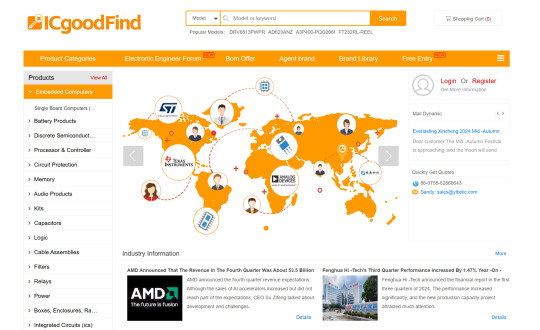
In terms of electronic component procurement, Yibeiic and ICgoodFind are your reliable choices. Yibeiic provides a rich variety of Xilinx products and other types of electronic components. Yibeiic has a professional service team and efficient logistics and distribution to ensure that you can obtain the required products in a timely manner. ICgoodFind is also committed to providing customers with high-quality electronic component procurement services. ICgoodFind has won the trust of many customers with its extensive product inventory and good customer reputation. Whether you are looking for Xilinx's FPGA, Zynq, or Versal series products, or electronic components of other brands, Yibeiic and ICgoodFind can meet your needs.
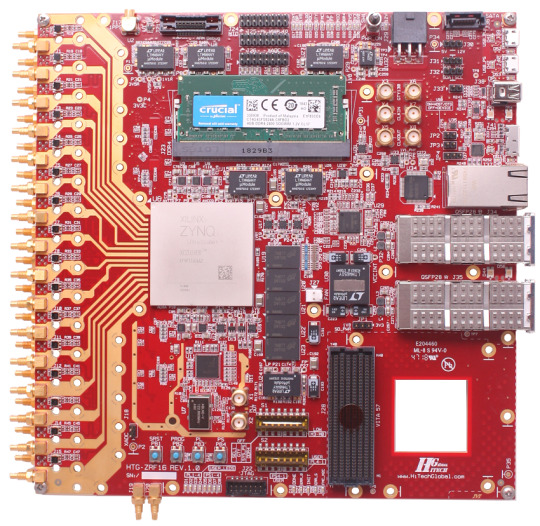
Summary by Yibeiic and ICgoodFind: Xilinx (Xilinx) as an important enterprise in the field of programmable logic devices, its products have wide applications in the electronics industry. As an electronic component supplier, Yibeiic (ICgoodFind) will continue to pay attention to industry trends and provide customers with high-quality Xilinx products and other electronic components. At the same time, we also expect Xilinx to continuously innovate and bring more surprises to the development of the electronics industry. In the process of electronic component procurement, Yibeiic and ICgoodFind will continue to provide customers with professional and efficient services as always.

4 notes
·
View notes
Text
youtube
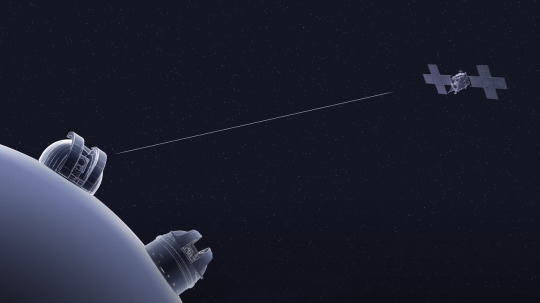

NASA’s Laser Comms Demo Makes Deep Space Record, Completes First Phase
The Deep Space Optical Communications tech demo has completed several key milestones, culminating in sending a signal to Mars’ farthest distance from Earth.
NASA’s Deep Space Optical Communications technology demonstration broke yet another record for laser communications this summer by sending a laser signal from Earth to NASA’s Psyche spacecraft about 290 million miles (460 million kilometers) away. That’s the same distance between our planet and Mars when the two planets are farthest apart.
Soon after reaching that milestone on July 29, the technology demonstration concluded the first phase of its operations since launching aboard Psyche on Oct. 13, 2023.
“The milestone is significant. Laser communication requires a very high level of precision, and before we launched with Psyche, we didn’t know how much performance degradation we would see at our farthest distances,” said Meera Srinivasan, the project’s operations lead at NASA’s Jet Propulsion Laboratory in Southern California. “Now the techniques we use to track and point have been verified, confirming that optical communications can be a robust and transformative way to explore the solar system.”
Managed by JPL, the Deep Space Optical Communications experiment consists of a flight laser transceiver and two ground stations. Caltech’s historic 200-inch (5-meter) aperture Hale Telescope at Caltech’s Palomar Observatory in San Diego County, California, acts as the downlink station to which the laser transceiver sends its data from deep space. The Optical Communications Telescope Laboratory at JPL’s Table Mountain facility near Wrightwood, California, acts as the uplink station, capable of transmitting 7 kilowatts of laser power to send data to the transceiver.
By transporting data at rates up to 100 times higher than radio frequencies, lasers can enable the transmission of complex scientific information as well as high-definition imagery and video, which are needed to support humanity’s next giant leap when astronauts travel to Mars and beyond.
As for the spacecraft, Psyche remains healthy and stable, using ion propulsion to accelerate toward a metal-rich asteroid in the main asteroid belt between Mars and Jupiter.
Exceeding Goals
The technology demonstration’s data is sent to and from Psyche as bits encoded in near-infrared light, which has a higher frequency than radio waves. That higher frequency enables more data to be packed into a transmission, allowing far higher rates of data transfer.
Even when Psyche was about 33 million miles (53 million kilometers) away — comparable to Mars’ closest approach to Earth — the technology demonstration could transmit data at the system’s maximum rate of 267 megabits per second. That bit rate is similar to broadband internet download speeds. As the spacecraft travels farther away, the rate at which it can send and receive data is reduced, as expected.
On June 24, when Psyche was about 240 million miles (390 million kilometers) from Earth — more than 2½ times the distance between our planet and the Sun — the project achieved a sustained downlink data rate of 6.25 megabits per second, with a maximum rate of 8.3 megabits per second. While this rate is significantly lower than the experiment’s maximum, it is far higher than what a radio frequency communications system using comparable power can achieve over that distance.
This Is a Test
The goal of Deep Space Optical Communications is to demonstrate technology that can reliably transmit data at higher speeds than other space communication technologies like radio frequency systems. In seeking to achieve this goal, the project had an opportunity to test unique data sets like art and high-definition video along with engineering data from the Psyche spacecraft. For example, one downlink included digital versions of Arizona State University’s “Psyche Inspired” artwork, images of the team’s pets, and a 45-second ultra-high-definition video that spoofs television test patterns from the previous century and depicts scenes from Earth and space.
The technology demonstration beamed the first ultra-high-definition video from space, featuring a cat named Taters, from the Psyche spacecraft to Earth on Dec. 11, 2023, from 19 million miles away. (Artwork, images, and videos were uploaded to Psyche and stored in its memory before launch.)
“A key goal for the system was to prove that the data-rate reduction was proportional to the inverse square of distance,” said Abi Biswas, the technology demonstration’s project technologist at JPL. “We met that goal and transferred huge quantities of test data to and from the Psyche spacecraft via laser.” Almost 11 terabits of data have been downlinked during the first phase of the demo.
The flight transceiver is powered down and will be powered back up on Nov. 4. That activity will prove that the flight hardware can operate for at least a year.
“We’ll power on the flight laser transceiver and do a short checkout of its functionality,” said Ken Andrews, project flight operations lead at JPL. “Once that’s achieved, we can look forward to operating the transceiver at its full design capabilities during our post-conjunction phase that starts later in the year.”
More About Deep Space Optical Communications
This demonstration is the latest in a series of optical communication experiments funded by the Space Technology Mission Directorate’s Technology Demonstration Missions Program managed at NASA’s Marshall Space Flight Center in Huntsville, Alabama, and the agency’s SCaN (Space Communications and Navigation) program within the Space Operations Mission Directorate. Development of the flight laser transceiver is supported by MIT Lincoln Laboratory, L3 Harris, CACI, First Mode, and Controlled Dynamics Inc. Fibertek, Coherent, Caltech Optical Observatories, and Dotfast support the ground systems. Some of the technology was developed through NASA’s Small Business Innovation Research program.
TOP IMAGE: NASA’s Psyche spacecraft is depicted receiving a laser signal from the Deep Space Optical Communications uplink ground station at JPL’s Table Mountain Facility in this artist’s concept. The DSOC experiment consists of an uplink and downlink station, plus a flight laser transceiver flying with Psyche. Credit: NASA/JPL-Caltech
LOWER IMAGE: This visualization shows Psyche’s position on July 29 when the uplink station for NASA’s Deep Space Optical Communications sent a laser signal about 290 million miles to the spacecraft. See an interactive version of the Psyche spacecraft in NASA’s Eyes on the Solar System. Credit: NASA/JPL-Caltech
2 notes
·
View notes
Text
Agilex 3 FPGAs: Next-Gen Edge-To-Cloud Technology At Altera
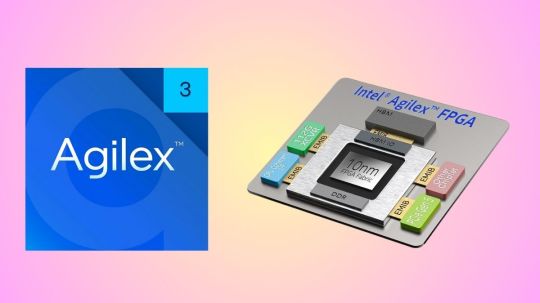
Agilex 3 FPGA
Today, Altera, an Intel company, launched a line of FPGA hardware, software, and development tools to expand the market and use cases for its programmable solutions. Altera unveiled new development kits and software support for its Agilex 5 FPGAs at its annual developer’s conference, along with fresh information on its next-generation, cost-and power-optimized Agilex 3 FPGA.
Altera
Why It Matters
Altera is the sole independent provider of FPGAs, offering complete stack solutions designed for next-generation communications infrastructure, intelligent edge applications, and high-performance accelerated computing systems. Customers can get adaptable hardware from the company that quickly adjusts to shifting market demands brought about by the era of intelligent computing thanks to its extensive FPGA range. With Agilex FPGAs loaded with AI Tensor Blocks and the Altera FPGA AI Suite, which speeds up FPGA development for AI inference using well-liked frameworks like TensorFlow, PyTorch, and OpenVINO toolkit and tested FPGA development flows, Altera is leading the industry in the use of FPGAs in AI inference workload
Intel Agilex 3
What Agilex 3 FPGAs Offer
Designed to satisfy the power, performance, and size needs of embedded and intelligent edge applications, Altera today revealed additional product details for its Agilex 3 FPGA. Agilex 3 FPGAs, with densities ranging from 25K-135K logic elements, offer faster performance, improved security, and higher degrees of integration in a smaller box than its predecessors.
An on-chip twin Cortex A55 ARM hard processor subsystem with a programmable fabric enhanced with artificial intelligence capabilities is a feature of the FPGA family. Real-time computation for time-sensitive applications such as industrial Internet of Things (IoT) and driverless cars is made possible by the FPGA for intelligent edge applications. Agilex 3 FPGAs give sensors, drivers, actuators, and machine learning algorithms a smooth integration for smart factory automation technologies including robotics and machine vision.
Agilex 3 FPGAs provide numerous major security advancements over the previous generation, such as bitstream encryption, authentication, and physical anti-tamper detection, to fulfill the needs of both defense and commercial projects. Critical applications in industrial automation and other fields benefit from these capabilities, which guarantee dependable and secure performance.
Agilex 3 FPGAs offer a 1.9×1 boost in performance over the previous generation by utilizing Altera’s HyperFlex architecture. By extending the HyperFlex design to Agilex 3 FPGAs, high clock frequencies can be achieved in an FPGA that is optimized for both cost and power. Added support for LPDDR4X Memory and integrated high-speed transceivers capable of up to 12.5 Gbps allow for increased system performance.
Agilex 3 FPGA software support is scheduled to begin in Q1 2025, with development kits and production shipments following in the middle of the year.
How FPGA Software Tools Speed Market Entry
Quartus Prime Pro
The Latest Features of Altera’s Quartus Prime Pro software, which gives developers industry-leading compilation times, enhanced designer productivity, and expedited time-to-market, are another way that FPGA software tools accelerate time-to-market. With the impending Quartus Prime Pro 24.3 release, enhanced support for embedded applications and access to additional Agilex devices are made possible.
Agilex 5 FPGA D-series, which targets an even wider range of use cases than Agilex 5 FPGA E-series, which are optimized to enable efficient computing in edge applications, can be designed by customers using this forthcoming release. In order to help lower entry barriers for its mid-range FPGA family, Altera provides software support for its Agilex 5 FPGA E-series through a free license in the Quartus Prime Software.
Support for embedded applications that use Altera’s RISC-V solution, the Nios V soft-core processor that may be instantiated in the FPGA fabric, or an integrated hard-processor subsystem is also included in this software release. Agilex 5 FPGA design examples that highlight Nios V features like lockstep, complete ECC, and branch prediction are now available to customers. The most recent versions of Linux, VxWorks, and Zephyr provide new OS and RTOS support for the Agilex 5 SoC FPGA-based hard processor subsystem.
How to Begin for Developers
In addition to the extensive range of Agilex 5 and Agilex 7 FPGAs-based solutions available to assist developers in getting started, Altera and its ecosystem partners announced the release of 11 additional Agilex 5 FPGA-based development kits and system-on-modules (SoMs).
Developers may quickly transition to full-volume production, gain firsthand knowledge of the features and advantages Agilex FPGAs can offer, and easily and affordably access Altera hardware with FPGA development kits.
Kits are available for a wide range of application cases and all geographical locations. To find out how to buy, go to Altera’s Partner Showcase website.
Read more on govindhtech.com
#Agilex3FPGA#NextGen#CloudTechnology#TensorFlow#Agilex5FPGA#OpenVINO#IntelAgilex3#artificialintelligence#InternetThings#IoT#FPGA#LPDDR4XMemory#Agilex5FPGAEseries#technology#Agilex7FPGAs#QuartusPrimePro#technews#news#govindhtech
2 notes
·
View notes
Text

'First light': NASA receives laser beam message from 16 million kilometers away
Fernando Valduga By Fernando Valduga 11/27/2023 - 08:43 in Space, Technology
An innovative experiment flying aboard NASA's Psyche mission has just reached its first major milestone by successfully carrying out the most distant demonstration of laser communications.
The technological demonstration may one day help NASA's missions to investigate space more deeply and discover more discoveries about the origin of the universe.
Launched in mid-October, Psyche is currently on its way to humanity's first glimpse of a metallic asteroid between the orbits of Mars and Jupiter. The probe will spend the next six years traveling about 3.6 billion kilometers to reach its namesake, located on the outside of the main asteroid belt.

Along with the tour is the demonstration of Deep Space Optical Communications technology, or DSOC, which is carrying out its own mission during the first two years of the trip.
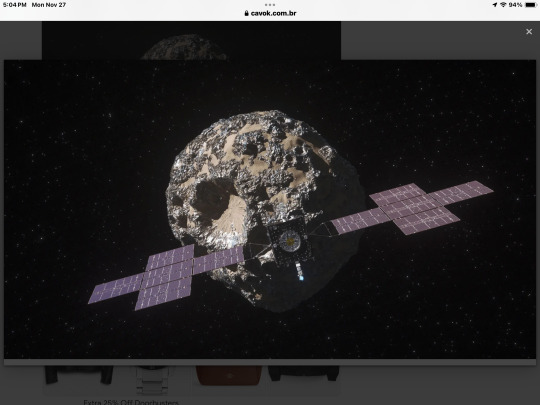
The technological demonstration was designed to be the most distant experiment of the U.S. space agency of high-bandwidth laser communications, testing the sending and receiving of data to and from Earth using a near-infrared invisible laser. The laser can send data from 10 to 100 times the speed of traditional radio wave systems that NASA uses in other missions. If it is totally successful in the coming years, this experience could be the future basis of the technology used to communicate with humans who explore Mars.
And the DSOC recently achieved what engineers called the "first light", the feat of successfully sending and receiving their first data.
The experiment sent for the first time a laser encoded with data from far beyond the Moon. The test data were sent from almost 16 million kilometers away and arrived at the Hale Telescope at the Palomar Observatory of the California Institute of Technology in Pasadena, California.
The distance between DSOC and Hale was about 40 times greater than the Moon is from Earth.
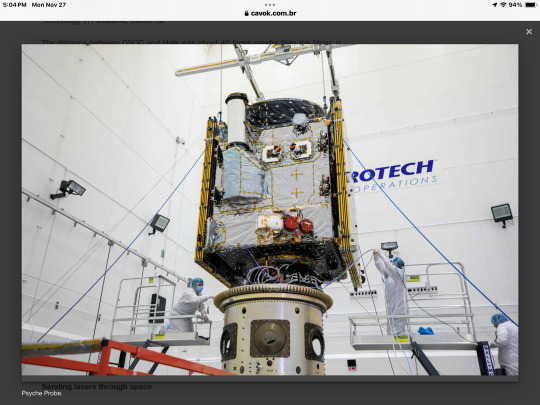
Psyche Probe.
“Achieveing the first light is one of the many critical milestones of the DSOC in the coming months, paving the way for communications with higher data rates, capable of sending scientific information, high-definition images and video streaming in support of humanity's next giant leap: sending human beings to Mars,” Trudy Kortes, director of technology demonstrations at NASA's Directorate of Space Technology Missions, said in a statement.
Sending lasers through space
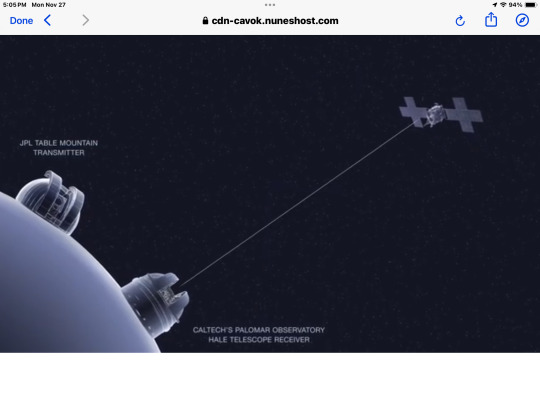
The first light, which occurred on November 14, happened when the laser flight transceiver instrument in Psyche received a laser beacon sent from the Optical Communications Telescope Laboratory at the Table Mountain facility of NASA's Jet Propulsion Laboratory near Wrightwood, California.
The initial beacon received by Psyche's transceiver helped the instrument point its laser to send data back to the Hale Telescope, which is located about 160 kilometers south of Table Mountain.
“The test (of November 14) was the first to fully incorporate ground resources and the flight transceiver, requiring the DSOC and Psyche operations teams to work together,” Meera Srinivasan, DSOC operations leader at JPL, located in Pasadena, California, said in a statement. "It was a formidable challenge and we have much more work to do, but in a short time we were able to transmit, receive and decode some data."
This is not the first time that laser communications have been tested in space. The first bidirectional laser communication test took place in December 2021, when NASA's Laser Communications Relay Demonstration was launched and went into orbit about 22,000 miles (35,406 kilometers) from Earth.
Since then, experiments have sent optical communications from the Earth's low orbit to the Moon. And the Artemis II spacecraft will use laser communications to send high-definition videos of a manned trip around the Moon. But DSOC marks the first time that laser communications have been sent through deep space, which requires incredibly accurate aiming and pointing over millions of kilometers.

The initial test of the capabilities of the technical demonstration will allow the team to work on the refinement of the systems used in the laser pointing accuracy. As soon as the team ticks this box, the DSOC will be ready to send and receive data to the Hale Telescope as the spacecraft moves away from Earth.
Future challenges
Although the DSOC does not send scientific data collected by the Psyche spacecraft because it is an experiment, the laser will be used to send bits of test data encoded in the photons of the laser, or quantum light particles.
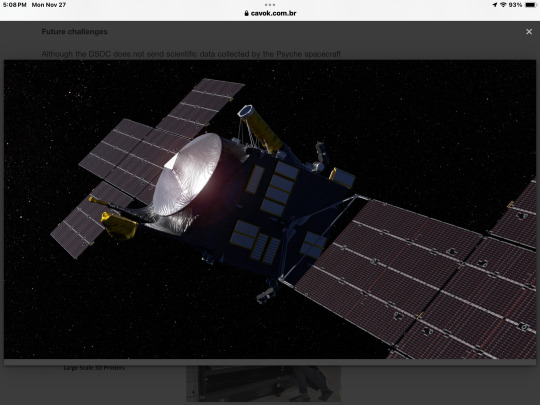
Detector matrices on Earth can capture the Psyche signal and extract the data from the photons. This type of optical communication can change the way NASA sends and receives data from its deep space missions.
“Optical communication is a blessing for scientists and researchers who always want more from their space missions and will allow human exploration of deep space,” Dr. Jason Mitchell, director of the Advanced Communications and Navigation Technologies Division of the Department of Communications and NASA's Space Navigation program said in a statement. "More data means more discoveries."
As Psyche continues his journey, more challenges await him.
youtube
The DSOC team will monitor how long it takes for laser messages to travel through space. During the first light, the laser took only 50 seconds to travel from Psyche to Earth. At the farthest distance between the spacecraft and the Earth, the laser is expected to take 20 minutes to travel one direction. And during that time, the spacecraft will continue to move and the Earth will rotate.
Meanwhile, the Psyche spacecraft continues to prepare for its main mission, connecting propulsion systems and testing the scientific instruments needed to study the asteroid when it arrives in July 2029. The mission will be able to determine whether the asteroid is the exposed nucleus of an ancient planetary building block since the beginning of the solar system.
Source: CNN
Tags: SpaceNASA
Sharing
tweet
Fernando Valduga
Fernando Valduga
Aviation photographer and pilot since 1992, has participated in several events and air operations, such as Cruzex, AirVenture, Dayton Airshow and FIDAE. He has work published in specialized aviation magazines in Brazil and abroad. Uses Canon equipment during his photographic work in the world of aviation.
Related news
SPACE
Space Operations Command reveals official 'futuristic' painting
11/26/2023 - 6:01 PM
A Chollima-1 rocket launched North Korea's first spy satellite on Tuesday, after two failed attempts since the summer. (Photo: NKNA)
SPACE
North Korea claims that it has successfully put spy satellite into orbit and will launch more
22/11/2023 - 21:17
Sierra Space's first Dream Chaser vehicle, called Tenacity, will soon go to a NASA facility in Ohio for environmental testing before a launch scheduled for spring 2024. (Photo: Sierra Space)
SPACE
Sierra Space completes the assembly of the first Dream Chaser, Tenacity
22/11/2023 - 11:14
TECHNOLOGY
NASA starts X-59 Quesst painting process
20/11/2023 - 23:03
SPACE
VIDEO AND IMAGES: SpaceX's Starship launch fails minutes after reaching space
11/18/2023 - 4:30 PM
SPACE
Satellite with Saab technology is launched by SpaceX
14/11/2023 - 08:10
3 notes
·
View notes